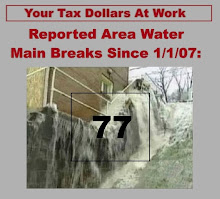
Except They Did So Earlier, Must Have Forgotten
Smithfield Bridge On Their List Of “Weight Restricted” Bridges
In the wake of the collapsed Interstate 35W bridge in Minnesota, Pennsylvania officials immediately went into spin mode, trying to portray our state’s abysmal bridge statistics as something other than alarming.
PennDOT’s initial Public Hoodwinking tactic was to redefine the problem as narrowly as possible. They quickly and proudly announced that Pennsylvania has 30 bridges of the same basic design as the collapsed Minneapolis bridge, only four of which are classified as “structurally deficient” and none being located in Allegheny County.
What about other types of bridges in the area? Are any of those bridges deficient as well? We unfortunately do lead the nation in structurally deficient bridges. A 2006 PennDOT report states that 23 percent of our 25,335 STATE-MAINTAINED bridges (There are thousands of other bridges in PA owned and maintained by counties, municipalities and private concerns) are classified as structurally deficient. However, the term “structurally deficient” can be misleading, they warn. Just because a bridge falls into that category doesn’t mean it is in imminent danger of collapse or failure.
The above parsing and selective statistics didn’t set well with the Beaver County Times. That newspaper decided it was time to get to the bottom of the situation and asked PennDOT to disclose the specific rankings of structurally deficient bridges in the area. Their request was made in April under the state’s Right To Know Law, long before the high-profile collapse of the 35W Bridge. PennDOT refused to release the information at that time and has again recently denied their request, saying this type of information does not fall into the category of “public records” as defined by law.
PennDOT spokesman Jim Struzzi confirmed their refusal to release the bridge safety information, saying the released information ……… not the unsafe bridges themselves, mind you, just the INFORMATION regarding unsafe bridges …….. could endanger the public by posing a security risk.
“There’s a fear that the general public might not understand what those numbers mean,” Struzzi said. “It might set off undue concern. A bridge might have a structurally deficient rating, and that might be low, but that doesn’t mean that bridge is unsafe or will collapse.”
Melissa Melewsky, media law counsel for the PA Newspaper Association, said PennDOT’s refusal might have sound legal standing, but only because Pennsylvania’s Right To Know Law is one of the weakest in the nation. What a surprise.
“It really comes down to the fact that we have a bad law and it needs to be changed,” Melewsky said. “I think the public has a right to know whether or not they’re traveling on safe bridges.”
While PennDOT hasn’t released a list showing each bridge’s specific safety ranking, it has already published a list of the worst offenders: Bridges that are closed or are weight-restricted because of their poor condition. In Allegheny County, the Smithfield Street Bridge and the Forbes Ramp from the Blvd of the Allies are just two of the bridges that are in poor enough condition to be weight restricted. The American Society of Civil Engineers says bridge rankings in the “structurally deficient” category run from “1” (Imminent Failure) to “4” (Poor). A rating of “0” means the bridge is beyond corrective action and is closed. The Pist-Gazette is hopeful that PennDOT would not be foolish enough to allow traffic on a Category 1 bridge (Imminent Failure) if weight restriction was the only “repair” system in place. Assuming this minimum level of competency, the Smithfield Bridge must therefore fall somewhere in the “2” to “4” category range.
Doing a scary bit of basic arithmetic ….The Smithfield Bridge has a weight limit of 23 tons and the average car (not light truck) weighs 1.6 tons. This means there should not be more than 15 “average sized cars” on the bridge at the same time. The Pist-Gazette could be wrong, but we fear this limit might be exceeded on a daily basis during rush hour!
How does PennDOT ensure the weight limit on the Smithfield Bridge (or any other bridge for that matter) is enforced? Are there signs posted? Are there electronic counters, much like parking garages, that let the 16th person in line know not to proceed forward, that the “Bridge is Full”?
It would appear from spokesman Struzzi’s comments that PennDOT feels this type of information would unnecessarily “endanger” the occupant of the 16th car by causing him “undue concern” whilst he trundles across the structrually deficient bridge.
Where does Gov. Rendell stand on the issue? He wants more money, of course. And he’s blaming the State Legislature for nixing his plan to lease the PA Turnpike. And he's bellyaching about their reticence for turning I80 into the PA Turnpike II.
Before Rendell, state and local politicians and other “civil servants” open their mouths to whine about the lack of funds and resources for our crumbling, unsafe infrastructure (including sewer systems and our electric grid), they should first slither under the nearest rock. While there they should contemplate the millions and billions of dollars they have wasted on building stadiums for their rich buddies, TIFs for PNC and other “needy” businesses, tunnels to nowhere, and a legion of other disgusting, wasteful pork projects. No matter how they spin it or where they try to deflect the blame, the general public has finally had their eyes opened. We know what we see and we’re seeing plenty.





1 comment:
When I was on Just Ducky Tours, we had a standard joke going over the Smithfield St. Bridge. "Don't worry that this is the oldest bridge in Pittsburgh, 'cause we have life-jackets on board!"
Ha ha! Hahahahahah! Each DUKW weighs about three tons.
Post a Comment